Pro Resin 1/72nd Loenings (Wright-Martin M-8, M-8-1 and LS-1)
|
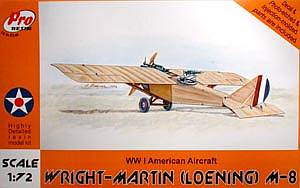 |
History
Upon receiving these kits, I immediately started into research. I knew
little to nothing about them, so I had to figure out their place in history.
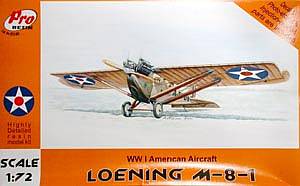 Grover
Loening was the first person in the US to earn a degree in aeronautical
engineering from Columbia University in 1910. After a stint with the Wright
Brothers, he left in 1917 to form his own company. At that time he bid
on an Army contract for a two-seat pursuit monoplane, which resulted in
the M-8 series. The prototype M-8 was too late to see action in World
War I, so the Army cancelled the contract. The M-8 was the first aircraft
to use rigid strut bracing which Loening patented. It was also the first
aircraft in the US military that was a monoplane. Grover
Loening was the first person in the US to earn a degree in aeronautical
engineering from Columbia University in 1910. After a stint with the Wright
Brothers, he left in 1917 to form his own company. At that time he bid
on an Army contract for a two-seat pursuit monoplane, which resulted in
the M-8 series. The prototype M-8 was too late to see action in World
War I, so the Army cancelled the contract. The M-8 was the first aircraft
to use rigid strut bracing which Loening patented. It was also the first
aircraft in the US military that was a monoplane.
Even though the initial contract was cancelled, the US Navy decided
it was a formidable aircraft after all, and re-ordered the M-8s post-war
(including the float-plane (LS-1) version). In addition, the Naval Aircraft
Factory (NAF) also built the Loening M-8 series under contract.
There appears to be a little bit of confusion as far as the type nomenclature
goes. According to AeroFiles
Hangar, the M-8 was built by Wright-Martin, exactly as the Pro Resin
boxtop shows. However, from there it becomes confusing. There was an M-8-0,
but there was only one 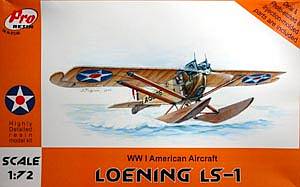 built
in 1918. Maybe an offshoot of the prototype? Plus, there were a number
of M-80s built by Loening. This site lists the next "version"
as being the M-81, and not the M-8-1. There were a number of M-81s built
by Loening, as well as the Naval Aircraft Factory. These documents also
show that the standard nomenclature for the seaplane version was M-81S
and lists only one LS-1 as being in existence. built
in 1918. Maybe an offshoot of the prototype? Plus, there were a number
of M-80s built by Loening. This site lists the next "version"
as being the M-81, and not the M-8-1. There were a number of M-81s built
by Loening, as well as the Naval Aircraft Factory. These documents also
show that the standard nomenclature for the seaplane version was M-81S
and lists only one LS-1 as being in existence.
However, take that all as you want. Regardless of what could be the
proper nomenclature for these machines, these models are a thing of beauty.
The Kit
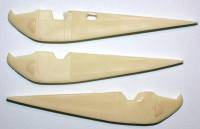 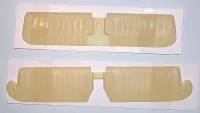 The
majority of the parts in all three kits are the same. Each kit comes with
the same photoetch, the same "smaller" parts and the same plastic-injected
guns. The M-8-1 and LS-1 have the same fuselage and wings while the M-8
comes with different wings, fuselage and horizontal tail. The LS-1 comes
with the floats, struts for the floats and the ventral fin. All resin
parts are very well cast with some very minor airholes. The photoetch
is top notch (and includes the typical clear acetate instrument piece)
and the plastic injected guns are some of the best ever produced. The
majority of the parts in all three kits are the same. Each kit comes with
the same photoetch, the same "smaller" parts and the same plastic-injected
guns. The M-8-1 and LS-1 have the same fuselage and wings while the M-8
comes with different wings, fuselage and horizontal tail. The LS-1 comes
with the floats, struts for the floats and the ventral fin. All resin
parts are very well cast with some very minor airholes. The photoetch
is top notch (and includes the typical clear acetate instrument piece)
and the plastic injected guns are some of the best ever produced.
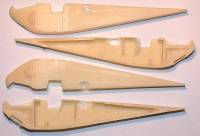 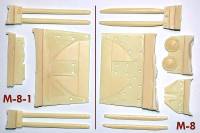 Construction
actually starts with assembling the engine. I'm trying to track down a
photo or three of the Hispano-Suiza 300hp engine as installed in the Loenings.
There appears to be more coverage of the cylinder heads than normal, but
it's difficult to tell in the very few images I have seen. After the engine
is assembled and put aside then construction continues with adding the
photoetch seat belts to the seats and then the seats, photoetch rudder
pedals and control stick to the floor. Construction
actually starts with assembling the engine. I'm trying to track down a
photo or three of the Hispano-Suiza 300hp engine as installed in the Loenings.
There appears to be more coverage of the cylinder heads than normal, but
it's difficult to tell in the very few images I have seen. After the engine
is assembled and put aside then construction continues with adding the
photoetch seat belts to the seats and then the seats, photoetch rudder
pedals and control stick to the floor.
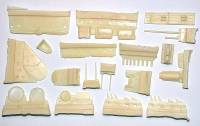 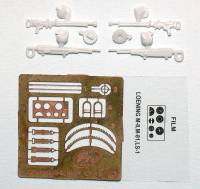 Now
the major construction can begin with first adding the cockpit floor assembly
to one of the fuselage halves then gluing the fuselage halves together.
I'll talk about cockpit colors in the section below on colors. Once the
fuselage is assembled then the wing, horizontal and vertical tail, along
with some of the smaller struts can be added. However, I would leave off
the struts until painting is finished. Once painting is finished, though,
then you can finish up the model with the struts, as well as rigging.
Unfortunately one thing left off the instructions was any type of rigging
diagram, so tracking down images of the real aircraft is a must to rig. Now
the major construction can begin with first adding the cockpit floor assembly
to one of the fuselage halves then gluing the fuselage halves together.
I'll talk about cockpit colors in the section below on colors. Once the
fuselage is assembled then the wing, horizontal and vertical tail, along
with some of the smaller struts can be added. However, I would leave off
the struts until painting is finished. Once painting is finished, though,
then you can finish up the model with the struts, as well as rigging.
Unfortunately one thing left off the instructions was any type of rigging
diagram, so tracking down images of the real aircraft is a must to rig.
Colors
In looking at images of the post-war built machines, I started to question
the color information that Pro Resin provides with their kits. Pro Resin
would have you finish all three kits in a Clear Doped Linen (CDL)-type
scheme. However, looking at the images shows me something else entirely.
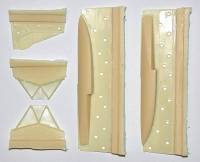 The
first prototype machine was definitely CDL and it's extremely obvious
from the image I have seen. This is the one machine that was first flown
before World War I ended. However, the other, post-war machines are the
ones in question. The
first prototype machine was definitely CDL and it's extremely obvious
from the image I have seen. This is the one machine that was first flown
before World War I ended. However, the other, post-war machines are the
ones in question.
The Squadron/Signal book Navy Air Colors, United States Navy, Marine
Corps, and Coast Guard Aircraft Camouflage and Markings, Vol. 1 1911-1945,
lists the color standards as clear dope 1911-1915; some aircraft (Curtiss,
Burgess) from 1916 on had an opaque, pigmented dope which was specified
as "Yellow" but varied from cream to yellow; mid-1917 there
was a specification for "English Khaki-Gray"; and in 1918, they
finally settled on "Naval Gray" as a standard.
But Volume 1 (1911 - 1939) of John Elliot's Masterwork The Official
Monogram U.S. Navy and Marine Corps Aircraft Color Guide does not
list "Naval Gray" as a color standard but does list "Aircraft
Gray" as a color standard, noting that it is "No. 16473 under
Federal Spec 595a, 8.8BG 6.9/0.6 in the Munsell scheme, No. 1645 under
Federal Specification TT-C-595, No. 512 under ANA Bulletin 166, 0.4PB6.82/o.9
under the Munsell Navy Standard (serial 78-B, dated01 Dec 1933, and no.
12 under 3-1 Old." (The previous is taken from Elliot's chart on
pages 190 - 191 of Volume 1 . There is a color chip for Aircraft Gray
on page 193 of the text.)
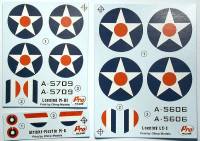 I'm
leaning toward the gray for one primary reason. There's an image of the
prototype that shows it's obviously CDL with possibly a black (or at least
"dark") nose. However, there is also an image of a post-war
machine in flight, and there is no "see through effect", evident
on CDL machines at all, which is why I'm leaning toward gray overall.
At the very least it's painted, and not left CDL. I'm
leaning toward the gray for one primary reason. There's an image of the
prototype that shows it's obviously CDL with possibly a black (or at least
"dark") nose. However, there is also an image of a post-war
machine in flight, and there is no "see through effect", evident
on CDL machines at all, which is why I'm leaning toward gray overall.
At the very least it's painted, and not left CDL.
What does this mean for the cockpit colors? Practically anything. The
Ardpol kit of the Aeromarine
39B calls for the cockpit to be painted "interior green".
However, as we have no documentation for the interior of the Loenings,
my guess is the same gray as would be applied to the exterior, so that's
the way I'm leaning right now (unless some other reference information
comes my way - soon).
Conclusion
All three of these kits are beauties. Pro Resin is one of the finest
1/72nd resin aircraft producers around and these models show the level
of quality they can achieve. I have recently started on the M-81 (M-8-1)
and there are very few problems to overcome with the build. Hopefully
I'll have it done soon.
These kits are highly recommended and my thanks to Pro
Resin for supplying them for review. |
|
